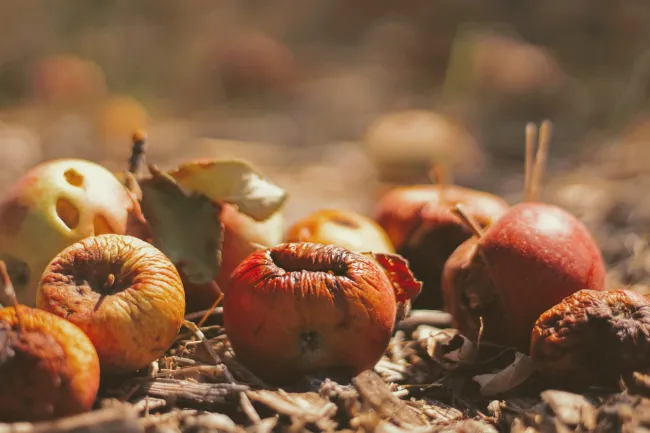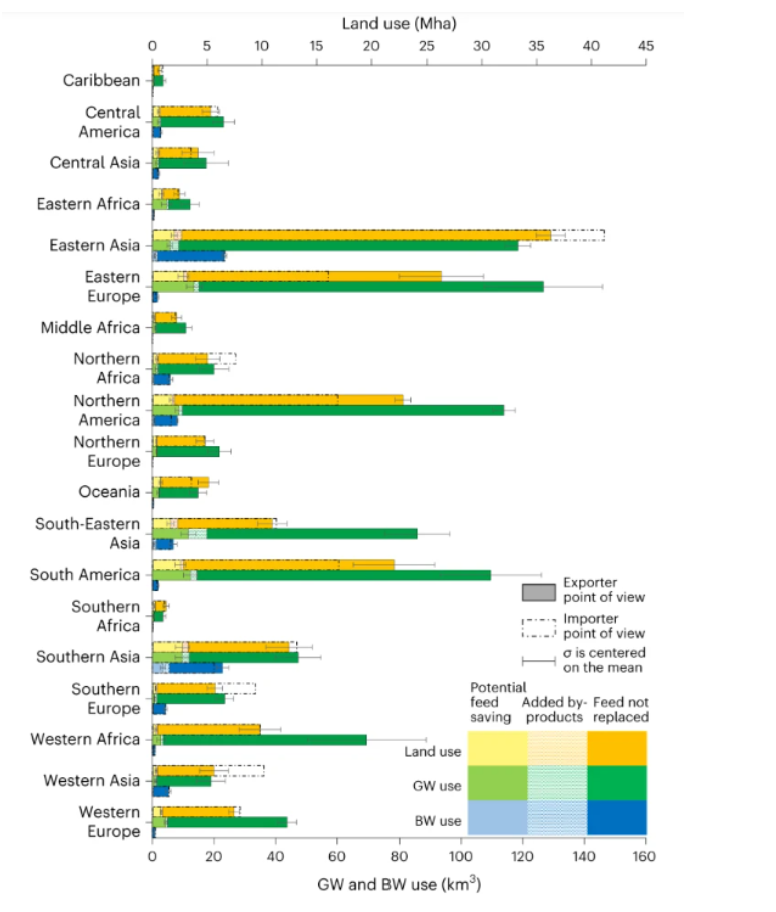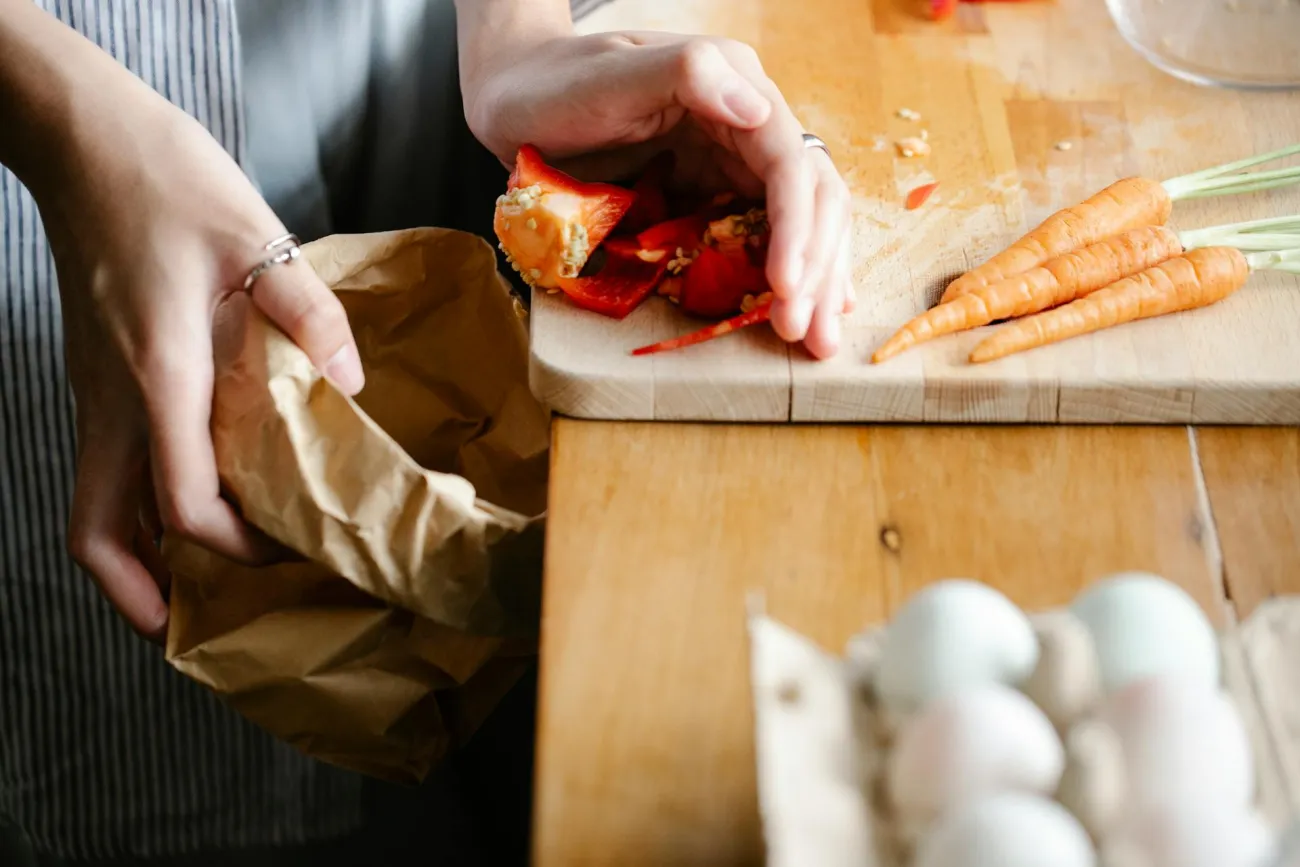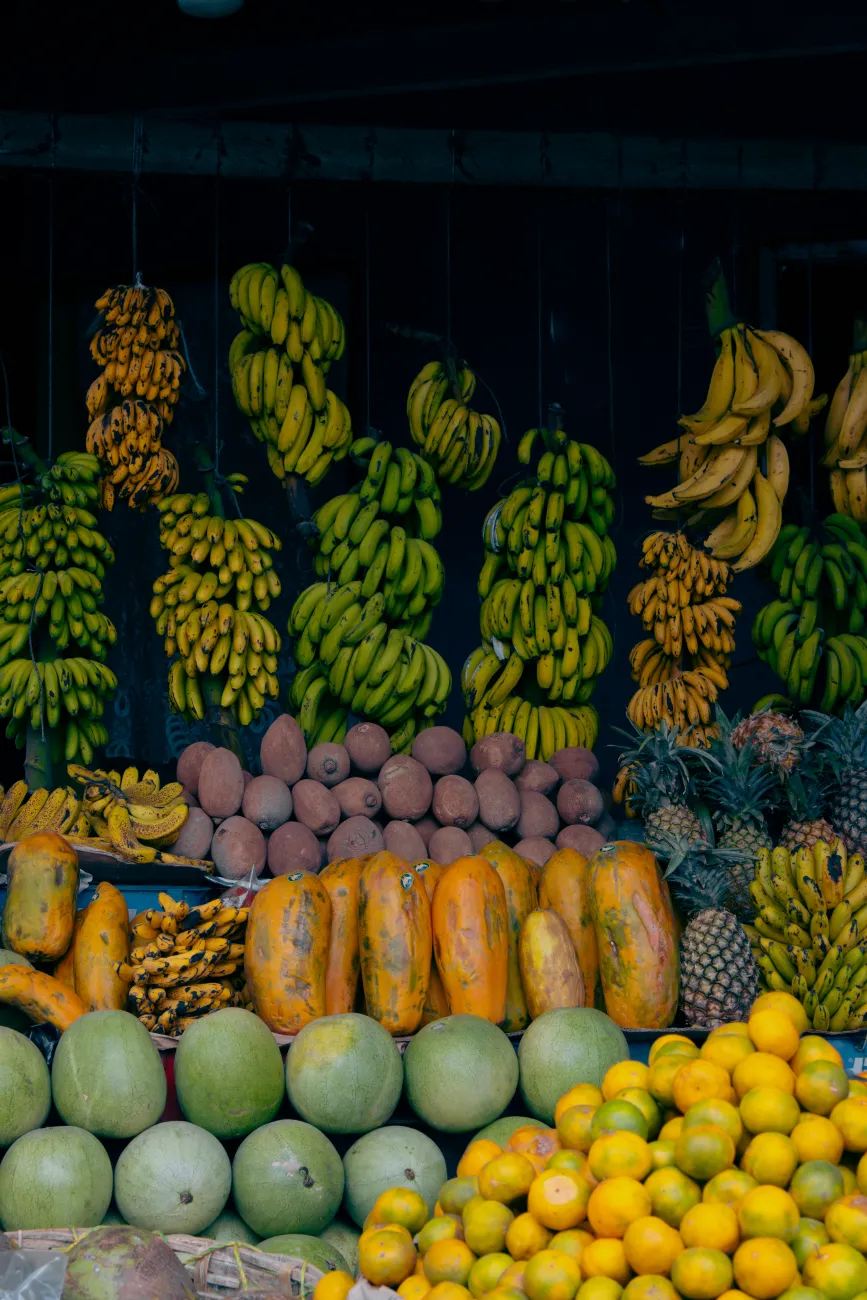Researchers find that substantial amounts of agricultural land and water could be saved by replacement of livestock feed with agricultural by-products. This article presents a predictive model which explores the impact of feed replacement with agricultural by-products on agricultural resource uses.

Summary
Over the next decade, global cereal production is projected to increase by 336 Mt by 2030, driven by higher feed use, particularly in fast-expanding livestock markets in developing countries. This is a concern not only for increased environmental impact, but equally because of competition for natural resources between the human food and the animal feed sectors (see more in our soy explainer). Feed uses 40% of arable land, combining carbohydrates (cereals and tubers) and protein crops (oilseeds and pulses). Of that land, 40% is used to grow cereal grains, accounting for a third of global cereal production. Water usage is also very high with animal production requiring 2,422 km3 (87.2% green water, 6.2% blue water and 6.6% grey water) of water per year in the 2000s, equal to one-third of total agricultural use, with 98% of that referring to the water footprint of the feed.
Cereal crops provide half of global daily calorie intake and a substantial percentage of overall protein intake; prioritising their direct human consumption is therefore a priority for food security. Healthy diet recommendations such as the EAT–Lancet Commission allows for the consumption of low to moderate quantities of poultry and eggs and very low amounts of red and processed meat. One strategy to contribute to this dietary transition is the reduction in the use of food-competing feed products and their replacement with low-impact feed, such as agricultural by-products and food waste.
This study assesses the land and green water (GW) and blue water (BW) use for the production of energy-rich feed crops from 2016-2018 and potential resource savings that could be achieved by replacing these with by-products from the human food system (cereal bran, beet pulp, molasses, distillers grains and citrus pulp). The estimates were based on calculations of the difference between the land and water use in the current baseline condition and a substitution scenario for agricultural by-products. By-products were also presumed to only be traded intraregionally and not among regions.
The authors combine country data on feed use from the FAOSTAT database with estimates of regional by-product availability and an analysis of suitable replacement criteria from Sandström et al. They first constructed the global material feed flow including consumption and trade patterns. Then the authors calculated the land and water resource use in the production of these feeds and their ‘virtual transfer’ through trade. They include a comprehensive and detailed trade analysis for the global cereal and cassava feed market, which enables a distinction between local and external cereal and cassava production and the quantification of the related virtual land and water trade. Whilst the authors note their focus on cereals and cassava is built from research done by Sandström et al., it is not clear why cassava was included as it is not mentioned in the referenced article. Finally, they evaluate the land, GW and BW savings that would result if this feed were replaced with by-products, whilst taking into account the the fact that 2.8–5.1 Mha of land, 15.3–26.3 km3 of GW and 4–7.5 km3 of BW are allocated to the production and processing from the primary crops from which they are derived. To include the associated environmental costs of the by-products, the proportion of environmental cost of the by-products was estimated and included, resulting in slightly lower resource saving estimations. Note that the article lacks a robust discussion of animal nutrition, merely stating agricultural by-products that are ‘suitable’ for animal consumption. This demonstrates an assumption that nutritional needs will be met in the simulated transition from energy-rich crops to agricultural by-products. Productivity and animal welfare may also be affected in the proposed dietary shift.
In the three year period of 2016–2018, almost 980 Mt of cereals and cassava (referred to as ‘energy-rich feed crops’) were used annually as animal feed, which is about one third of the global energy-rich crop production as reported by FAOSTAT. The remainder is used for human food consumption and bioenergy production. Maize is by far the most common energy-rich crop used as feed mainly in the Americas and in Asia, topping the following list::
- Maize (64%)
- Wheat (13%)
- Cassava (9%)
- Rice (4%)
- Sorghum (2%)
These six crops account for 95% of the energy-rich crops used as feed. The major consumers of these crops can be found in Eastern Asia (27%), Europe (19%) and North America (16%). The production of the energy-rich feed needed to meet this demand requires 185.2 Mha of agricultural land; this area represents one-fourth of the global area harvested with energy feed crops and 13% of all arable land. Additionally, 80.9 km3 and 863.5 km3 of BW and GW were needed to grow these feed crops which represents 8% of total BW use in agriculture and 15% of total GW use for crop production worldwide. Cereals and cassava are less traded than other crops such as oilseeds (soybean and oil palm); in fact, only 20% of these energy-rich crops used as feed are not locally produced. Cereal and cassava production is relocated through trade and the associated virtual land flows. Eastern Europe, Northern America and South America are net land exporters, while Eastern and Western Asia and Southern Europe are net importers.
The full results of this analysis are presented in Figure 1, which shows current land, GW, and BW use for cereal and cassava in the given regions. Solid bars denoted the point of view of exporter countries whilst dotted bars are the point of view of importer countries. Lighter shades represent the potential land, GW and BW that can be saved whilst darker shades denote current use. Dashed shades show the added land, GW, and BW use associated with the replacement of energy-rich feeds with by-products.

Figure 1: Global use of natural resources to produce energy-rich feed crops and the associated potential savings achievable with their replacement.
The replacement of 111 Mt of energy-rich feed crops as estimated by Sandström et al. with available agricultural by-products suitable for livestock diets could save, on average, 21.6 Mha of agricultural land, 106 km3 of green water and 11.3 km3 of blue water, with no reduction in livestock production. This represents 2.9% of the global area harvested for energy rich crops, 1.8% of GW and 1.1% of BW. The authors account for the environmental cost of the by-products, estimating that 2.8–5.1 Mha of land, 15.3–26.3 km3 of green water and 4–7.5 km3 of blue water are allocated to their production and processing from the primary crops they are derived from. The regions that would most benefit from the use of agricultural by-products from a green water perspective would be Southern, Eastern and South-Eastern Asia, and Eastern Europe. These regions still have relatively low agricultural yields compared with Northern America and Western Europe, where the yield gap is smaller, especially for cereals. Blue water savings are expected to occur in Asia, where cereal production is traditionally irrigated.
In a climate with increasing limitations on land and water use for agriculture, feed-food competition is strongly determining food security in many regions. In addition to this, bioenergy production competes with livestock feed both for agricultural by-products and increasingly for arable crops, particularly as a result of financial incentives to mitigate the recent energy crisis. Policy will need to be put in place to manage these competing demands. There is also huge potential for other alternative feeds to reduce feed-food competition, derived from food waste, plant by-products not considered in this article such as leafy greens, and insects. However, their use will require further policy interventions to change current restrictions on what can be legally traded as animal feed. Finally, the replacement of other feed types that compete with food produced for direct human consumption such as oilseed co-products (that is, soybean and palm kernel cakes) would be a winning strategy to reduce human pressure on the environment. This is because oilseed production is a major driver of land use change, large-scale deforestation, biodiversity losses and greenhouse gas emissions.
Abstract
While animal-source foods contribute to 16% of the global food supply and are an important protein source in human diets, their production uses a disproportionately large fraction of agricultural land and water resources. Therefore, a global comprehensive understanding of the extent to which livestock production competes directly or indirectly with food crops is needed. Here we use an agro-hydrological model combined with crop-specific yield data to investigate to what extent the replacement of some substitutable feed crops with available agricultural by-products would spare agricultural land and water resources that could be reallocated to other uses, including food crop production. We show that replacing 11–16% of energy-rich feed crops (that is, cereals and cassava) with agricultural by-products would allow for the saving of approximately 15.4–27.8 Mha of land, and 3–19.6 km3 and 74.2–137.8 km3 of blue and green water, respectively, for the growth of other food crops, thus providing a suitable strategy to reduce unsustainable use of natural resources both locally or through virtual land and water trade.
Reference
Govoni, C., D’Odorico, P., Pinotti, L. and Rulli, M.C., 2023. Preserving global land and water resources through the replacement of livestock feed crops with agricultural by-products. Nature Food, pp.1-11.
Read the article here and for more on the future of livestock and the feed-food competition see our podcast Meat: the Four Futures?, our explainers on What is feed-food competition?and What is food loss and food waste?, and our blog A role for livestock in a sustainable food system




Comments (0)